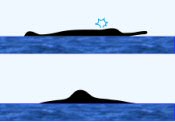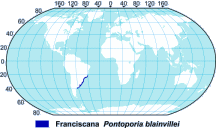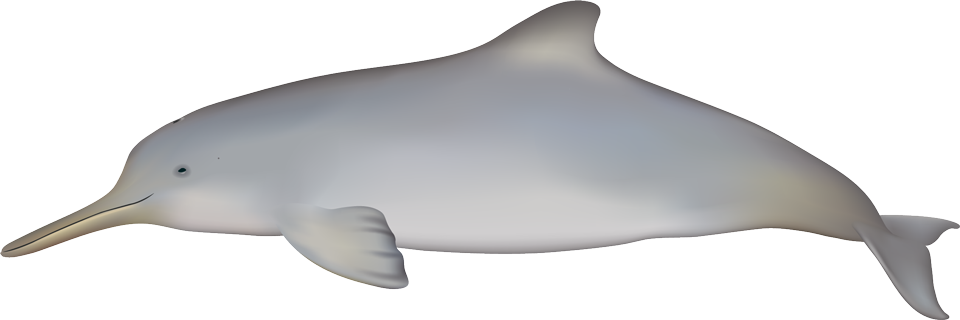Franciscana
CLASS: Mammalia
ORDER: Cetacea
SUBORDER: Odontoceti
FAMILY: Platanistidae
GENUS: Pontoporia
SPECIES: blainvillei
The name "Franciscana" is of unknown origin, but one suggestion connects it to the monks of the Franciscan order, the "gray friars" who were involved in the earliest European settlement of Uruguay; the dolphin's grayish color may be responsible for its curious name. Although it is grouped with the other freshwater species, its cervical vertebrae are unfused. It looks more "dolphin-like" than other freshwater species and is not really a freshwater inhabitant at all. (Richard Ellis, from Dolphins and Porpoises.)
Physical Description
Commonly known by the Spanish name of Franciscana, this dolphin has a rather plump body. Its head is rounded, narrowing to a poorly defined neck. As is the case with other members of the river dolphin group, its neck vertebrae are unfused. This species is the only fresh water dolphin with a true dorsal fin, which is situated at the center of the back. Franciscanas can be identified by the long, slender beak which is the longest beak relative to body size of any dolphin. Its beak contains 50 to 60 small, sharp teeth in each half of the upper and lower jaws for a total of 200 to 240 teeth. Although its eyes are small, its eyesight is believed to be well developed.

Surface Characteristics
Color
The upper part of its back is grayish-brown, shading to a lighter shade of brown on the under side of its body. Older animals become so light in color the fishermen of the La Plata estuary call them "white ghosts."
Fins and Fluke
Its dorsal fin is tall, triangular in shape with a rounded tip, and is located at the mid section of the back. It has broad flippers that are rounded at the tips, and its flukes are small and curved with a notch in the center.
Length and Weight
The Franciscana is one of the smallest cetaceans; average length for both males and females is 6 feet (1.8 m). Weight for males averages 80 pounds (36 kg) and 90 pounds (40 kg) for females with a maximum of 110 pounds (50 kg) for both sexes.
Feeding
The diet of the Franciscana consists of many varieties of fish, squid, and shrimp.
Mating and Breeding
Sexual maturity is reached at 2 to 3 years of age or when males are 4.5 feet (1.3 m) and females are 4.6 feet (1.4 m); calves are about 27 inches at birth (70 cm) and weigh 15 to 20 pounds (7 to 9 kg). Gestation period is 10.5 months and calves are nursed for 9 months. Most births occur between October and January.

Range Map
Distribution and Migration
The Franciscana inhabits the shallow coastal waters of Uruguay, Argentina, and Brazil from the Valdes Peninsula in Argentina north to the Rio Grande do Sul River near Rio de Janiero in Brazil.
Natural History
This species tends to travel alone or in small groups of a few animals. It is inconspicuous at sea; its blow is hardly detectable and it does not roll or jump out of the water. Sometimes it will approach boats, making it easy to see the long beak and to identify it as a Franciscana. Lifespan has been estimated to be only 15 to 20 years.
Status
Several hundred Franciscanas are accidentally caught in shark nets each year with past estimates as high as 1500. Scientists in South America recently carried out the first aerial surveys of these Franciscanas and estimate their population to be around 40,000 within the coastal waters of Brazil and Uruguay.
Bibliography
- Brownell, R.L. 1989. in Handbook of Marine Mammals (Ridgway & Harrison Eds.). Academic Press. pp. 45-67.
- Jefferson, T.A., M.A. Webber, R.L. Pitman. 2015. Marine Mammals of the World: A Comprehensive Guide to their Identification, 2nd edition. Elsevier/AP.
Acknowledgements
Illustrations courtesy Uko Gorter, copyright © 2017 all rights reserved.
FACT SHEETS MAY BE REPRINTED FOR EDUCATIONAL OR SCIENTIFIC PURPOSES
|



